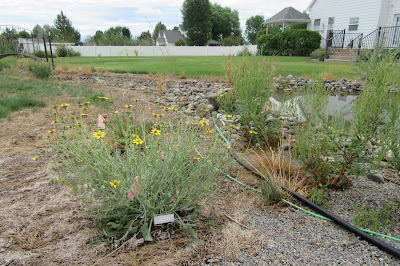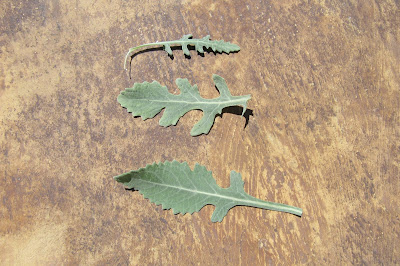August
is a month of variable weather in Western Colorado. Sometimes it’s blazing hot for days on end.
Other times we get torrential rains, thanks to the summer monsoons. Some plants seem to take it all in stride,
looking good no matter what the conditions.
One such native perennial is the Chocolate flower, Berlandiera
lyrata.
The scientific name is pronounced ber-lan-dee-AIR-uh
ly-RAY-tuh. This plant provides a spot of summery golden
yellow in Mother Nature’s Montrose Garden.
Chocolate
flower is also known by the common names of Chocolate daisy, Lyreleaf greeneyes,
Green-eyed lyre leaf, Brooch flower and, in Spanish, as Coronilla and Hierba de
la Víbora. The genus Berlandiera contains only six
species, all native to the Southwestern/Southern U.S. and Mexico.[1] The name honors Jean-Louis Berlandier
(1805-1851), a French-Swiss physician, naturalist and anthropologist who collected
plants in northern Mexico, New Mexico and Texas in the early 1800s. He lived most of his adult life in Mexico,
where he practiced medicine. [2] The species
name lyrata reflects the shape of the
leaves, which are curved like a lyre.
Berlandiera lyrata belongs to the Sunflower
family; the Asteraceae. The American West is blessed with an
extraordinary number of wonderful sunflower species. Many of them make cheerful, summer garden flowers
(for our post on the Annual sunflower see: https://mothernaturesmontrosegarden.blogspot.com/2019/08/plant-of-month-august-annual-common.html.
Many Asteraceae species also have
a history of human use: as food and/or as medicinal plants, as well as other
practical other uses.
Chocolate
flower grows from western Kansas, Oklahoma and Texas to Colorado, New Mexico
and Arizona. In Mexico, it can be found
in the states of Chihuahua, Coahuila, Nuevo León, San Luis Potosí, Durango,
Sonora, Zacatecas, Aguascalientes and Jalisco. [3] It only grows native in the extreme southeastern
part of Colorado, although it’s widely planted in Colorado gardens. It
grows in well-drained sand, loam and clay, often in places with disturbed soils
such as irrigated fields and roadsides. In more natural settings, it grows on plains,
mesas and in native grasslands with mesquite, oak and juniper.
Chocolate
flower is an herbaceous perennial with a mounded form, 1-2 ft. tall and 1 to 2
1/2 ft wide. It typically has many short branches from a basal taproot. The
entire plant dies back to the taproot in cold winters (like ours in Montrose,
CO). The foliage is coarse and gray-green
in color, particularly so in hot climates. The leaves are deeper green above
and whitish below, with irregular pinnate lobes (below). In hot climates, the
foliage is covered with dense, short hairs.
Leaf shape varies from oblong, to spatula-shaped or curved like a lyre,
often on the same plant. The leaf
margins may have rounded teeth; and leaves may be lobed or not.
The
flowers of Berlandiera lyrata grow in
sunflower-type heads (the technical term is a ‘pseudanthium’, meaning ‘false flower’). Plants can bloom from late spring through summer and even into fall. The yellow ray flowers (look like petals)
attract pollinators to the smaller, plainer, central disk flowers (above). In
most Asteraceae, the disk flowers produce the seeds. But Chocolate
flower is different: the rays are female flowers that produce the seeds (one seed
per ray flower) and the male disk flowers produce both the pollen and the fragrance.
The ray flowers are golden yellow above, and yellow striped with maroon below. The
disk flowers in this species are maroon-brown; and their stamens (below) are
the plant part with the most intense scent.
Berlandiera lyrata is known as Chocolate flower because of the scent of dark chocolate that emanates from the plant, and especially from the flowers. Enjoy the aroma while you drink your morning coffee or tea near the plant. The wafting scent is absolutely heavenly! The scent is strongest in the early morning, after the day starts to warm up – before about 10:00 o’clock in our summer garden - and is probably used to attract pollinators.
We have noted a species
of flower fly (hover fly) that commonly visits the flowers in the early morning
(above). Note how well the colors of
this pollinator blend with those of the Chocolate flower. While the flowers are said to attract a range
of insect pollinators, these hover flies are the most consistent visitors in
our Western Colorado garden. The diurnal pattern of scent release is
related to several other characteristics that make this a unique sunflower
indeed.
Herbaceous
plants from hot, dry climates cope in several ways. Some are annuals,
completing their life cycle before the summer heat. Some perennials – particularly
those from summer-dry places like S. California – die back with the heat. Others have developed waxy coats, white hairs
and other means of dealing with heat and drought.
Perennials
that experience both summer heat/aridity and summer monsoonal moisture face
unique challenges. They must survive the heat and drought; yet must be able to
grow and flower at a moment’s notice, when the monsoons arrive. This makes them
particularly interesting plants to observe.
Chocolate flower is a good example of the traits many such plants
exhibit.
We’ve
already noted the foliage characteristics that make Chocolate flower well
suited to hot climates. The light color, dense hairs and lobed leaves all are
adaptations to hot, dry conditions. In
fact, these characteristics are shared with many plants of hot climates, including
other sunflowers. But additional floral adaptations make this plant unique among
the sunflowers.
When
the temperature rises, the ray flowers of the youngest heads close over the
disk flowers (above). In older heads,
the ray flowers become pale (sometimes white) before dropping off in the heat. Left is a green head – hence the name
green-eyes – which is attractive in its own way. If
pollinated, the seed develops, dries and finally falls, remaining attached to
the cupped bracts and other dried flower parts (below). If happy, the plant will produce seedlings
and naturalize.
Chocolate
flower likes a sunny position in the garden.
It’s fine with any well-drained soil. And it can take the heat – it looks
fine on even our hottest days. It does well in slightly alkaline soils (to pH
around 8.0). Plant in a drier part of
the garden. For the first summer give the plant regular water, then switch to
infrequent, deep irrigation. Chocolate
flower does best when soils are allowed to dry out between waterings. In many
gardens, an established plant can get by with weekly summer irrigation. Or locate it in an area that gets minimal
irrigation from sprinklers. Plants will
get leggy – even succumb to root fungi – in too damp soils.
Management
of Chocolate flower is easy, once the plant is established. Choose location carefully
and don’t move established plants (long taproot; plants resent being moved). Mulch with gravel (good for re-seeding) or
not at all. Give a light dose of fertilizer (half-strength) in fall after
weather cools a bit. Avoid planting in highly amended soils; this plant likes a
lean soil and will become floppy and even sickly in too rich a medium. Cut plant
back hard (to a height of 2 to 3 inches) in early to mid-spring. Plant will leaf out again with warm weather.
Remove
spent flowers if you want the plant to bloom all season long. Or let the seeds
develop and either collect them or let the plant naturalize. Of course, you may lose some seeds to hungry
Goldfinches and other seed eaters. And
thin out any unwanted seedlings in late spring.
That’s pretty much all that’s needed.
Chocolate
flower can be grown at elevations up to about 7000 ft (2100 m), in USDA Zones 4
to 9 or even 10. It’s an excellent choice for hot, dry gardens (or such places
in any Southwestern garden). Its flowers
attract insect pollinators and hummingbirds, and the seeds tempt seed-eating
birds. If you need a spot of summer morning
yellow, this is an easy to grow alternative.
Chocolate
flower’s size makes it a good choice for edges of water-wise flower beds and
pathways. It’s also nice with other
native wildflowers and grasses. Pair it
with purple summer/fall native asters for a lovely contrast. If your garden tends to be moist, include it
in a rock garden, where it can benefit from increased drainage.
Of
course, this plant adds its unique charm to a scent garden. Plant it next to a
seating area, where you can enjoy the aroma of Chocolate on summer mornings. The aroma also repels deer. And the flowers have traditionally been used
as a seasoning for sausages by Southwestern natives. Some Native American cultures also used the
plant to treat stomach problems; and the smoke of dried, burned roots to calm
nervousness. [4]
In
summary, Chocolate flower is an easy-to-grow native perennial for Southwestern
gardens. It has many things to recommend it: color, scent, habitat value and
more. So, look around your garden. Do you
have a dry, sunny spot for this interesting native treasure?
For a
gardening information sheet see: https://www.slideshare.net/cvadheim/gardening-sheet-berlandiera-lyrata
___________
1.
https://www.fs.fed.us/wildflowers/plant-of-the-week/berlandiera_lyrata.shtml
2.
https://santafebotanicalgarden.org/august-2012/
3.
https://en.wikipedia.org/wiki/Berlandiera_lyrata
4.
http://naeb.brit.org/uses/search/?string=Berlandiera+lyrata
___________________________________________________
We
welcome your comments (below). You can
also send your questions to: monaturesmontrosegarden@gmail.com



















No comments:
Post a Comment